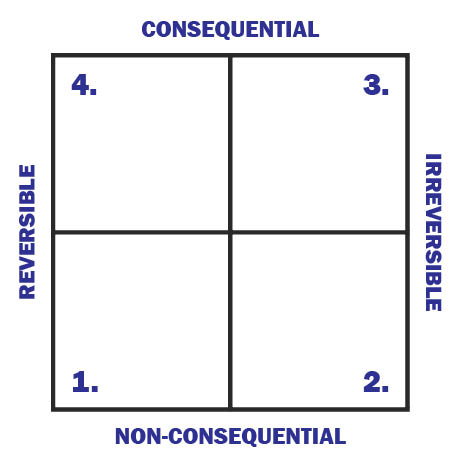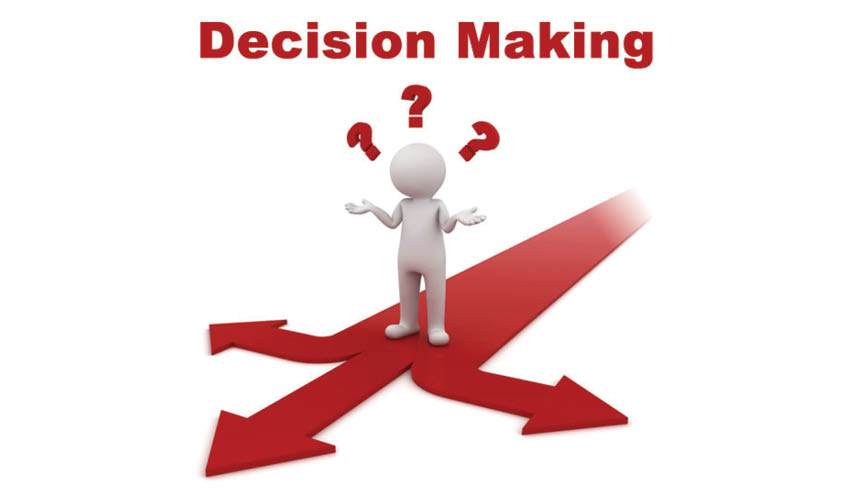Mental Health Specialist, Hormuzd Daruwalla specializes in NLP, GESTALT, Hypnotherapy, TA and REBT. A dynamic and multi-dimensional professional, who has tasted success across different genres, Hormuzd holds degrees in Civil Engineering and Management, and manages multiple businesses as an entrepreneur. He shares his expertise with the NGO – Adore, a mental health helpline, as also does a lot of pro bono work, to give back what we take from society. He wishes to help you understand the basics of how our minds work – as the platform from where we can elevate our thoughts and our lives.
.
Why are some decisions easy and some hard to make? Why do we procrastinate sometimes while, at other times, are able to be very clear about our decisions? Often, we end up procrastinating because we are unable to make decisions in a timely manner… while sometimes we’re unable to decide which course of action to engage in, at others we’re unable to come to the decision of even wanting to move ahead in the first place.
Let’s first understand the concept of procrastination from the purview of decision-making, via the Decision Making Quadrant, by classifying our decisions into two main categories:
- Consequential And Non-Consequential Decisions; and
- Reversible And Non-Reversible Decisions

Each quadrant of the Decision-Making Quadrant thus symbolizes decisions that are:
Quadrant 1: Reversible and Non-Consequential
Quadrant 2: Irreversible and Non-Consequential
Quadrant 3: Irreversible and Consequential
Quadrant 4: Reversible and Consequential
Let’s take, for eg., Cyrus’s beautiful wife picks up two dresses and asks him, “Darling, which one do I wear tonight – the black one or the red one? Cyrus instantly replies – ‘the black one’. This decision is very easy for Cyrus to make – it lies in Quadrant 1 – it’s ‘Reversible And Non-Consequential’. The decision was made in a jiffy!
Let’s now take another example. Cyrus is now old and has the last of his life savings remaining. He needs to make a decision as regards where he will invest the last of his life savings. This decision for him lies in Quadrant 3 – ‘Consequential And Irreversible’. He will now procrastinate to take his time to make this decision.
And the same holds true for most of us – that is, when we are faced with important decisions that will result in consequences impacting our lives and are then irreversible, we will also tend to push that decision making for a later date.
But some decisions can only be procrastinated for so long! So, let’s help ourselves by employing this 5-Step Decision-Making Process which will prove very beneficial to us in making the right decision and not having to push it for later.
The 5-Step Decision-Making Process:
Step 1 – Break It Down! Remember the saying, ‘How to eat an elephant? One bite at a time!’ Similarly, break the larger decision into smaller parts and use the Decision-Making Quadrant table to put them in Quadrants 1, 2, 3 or 4, accordingly. This helps evaluate the number of smaller decisions you need to make to reach to main goal.
Step 2 – Data Collection: All decisions – small or big – to be made right, require relevant data or information. The more data you have, the more precise is your capacity to make the right decision for yourself. So, run your information through the 4 quadrants and this will help you come closer to making the right decision.
 Step 3 – ASAP And ALAP: Sometimes, decisions are time-bound. For such decisions, the best way to reach a consensus is to start making the smaller decisions or taking smaller actions first. Thus, all Quadrants 1 (Reversible and Non-Consequential) decisions should be made ASAP (As Soon As Possible), and all Quadrant 3(Irreversible and Consequential) decisions should be made ALAP (As Late As Possible). You can procrastinate, think, calculate and take the maximum possible time to make Quadrant 4 (Reversible and Consequential) choices. As you keep continue making the smaller decisions, other venues will open up. As more data is made available, better choices can be made by you with greater confidence.
Step 3 – ASAP And ALAP: Sometimes, decisions are time-bound. For such decisions, the best way to reach a consensus is to start making the smaller decisions or taking smaller actions first. Thus, all Quadrants 1 (Reversible and Non-Consequential) decisions should be made ASAP (As Soon As Possible), and all Quadrant 3(Irreversible and Consequential) decisions should be made ALAP (As Late As Possible). You can procrastinate, think, calculate and take the maximum possible time to make Quadrant 4 (Reversible and Consequential) choices. As you keep continue making the smaller decisions, other venues will open up. As more data is made available, better choices can be made by you with greater confidence.
Step 4 – The Sniper Theory: We know that the task given to a sniper is to assassinate a target. He has only one shot to hit or miss the target. So, his task is a typical a Quadrant 3 task. Before he goes for his final shot, he test-fires a bullet to check the distance, wind velocity and direction, etc. After firing the shot, he re-adjusts his position to take a final shot. In principle, you can do a small test to see if the decision you are making, is the right or wrong one.

Step 5 – Emotion and Bias: It’s only human to look at situations through our biased perspectives, through emotion and emotional bias. When you need to make decisions, try to view it from a third-person perspective, like you’d advise a friend. It’s important to check for and remove the emotional bias from the situation!
If you can run through this algorithm for the decisions you take, you will be surprised how accurate and right things will turn out! Remember – ‘the future is only a bunch of decisions that you have taken in the present.’ The decisions you make today will shape your tomorrow, so do it right!
- Decision Making And Procrastination - 10 October2020
- Anger - 8 August2020
- Why We Do What We Do - 25 July2020
